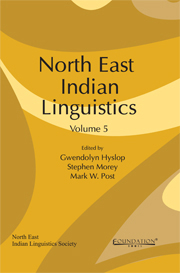Book contents
- Frontmatter
- Contents
- About the Contributors
- Foreword
- A Note from the Editors
- Contact and genetic linguistics
- 1 Koch dialects of Meghalaya and Assam: A sociolinguistic survey
- 2 The Siyom River Valley: An essay on intra-subgroup convergence in Tibeto-Burman
- 3 On the internal phylogeny of East Bodish
- Historical-comparative Tibeto-Burman grammar
- The North East Indian noun phrase
- Assamese grammar
- Advances in Boro-Garo phonology
- Poetics and text
2 - The Siyom River Valley: An essay on intra-subgroup convergence in Tibeto-Burman
from Contact and genetic linguistics
Published online by Cambridge University Press: 05 September 2013
- Frontmatter
- Contents
- About the Contributors
- Foreword
- A Note from the Editors
- Contact and genetic linguistics
- 1 Koch dialects of Meghalaya and Assam: A sociolinguistic survey
- 2 The Siyom River Valley: An essay on intra-subgroup convergence in Tibeto-Burman
- 3 On the internal phylogeny of East Bodish
- Historical-comparative Tibeto-Burman grammar
- The North East Indian noun phrase
- Assamese grammar
- Advances in Boro-Garo phonology
- Poetics and text
Summary
Introduction
This paper has a fairly modest primary goal: to remove a question mark ‘?’ which appears to the right of Galo (i.e., ‘Gallong’) in Sun's (1993; Sun 2003) provisional family tree of the Tani branch of Tibeto-Burman languages (Figure 1).
The question mark appears in Sun's tree for a good reason: as he was compiling his masterful comparative-historical study of the Tani languages in the years leading up to 1993, most of the evidence available to Sun suggested aligning Galo genetically with Western Tani languages such as Hills Miri, Nyishi and Tagin. At the same time, though, Galo exhibited several features which were more characteristic of Eastern Tani languages such as Bori, Padam and Mising. At the time of Sun's writing, there was no obvious means of understanding why this should have been the case. The paper's second goal, then, will be to attempt to explain this situation on the basis of data and observations from the Western/Eastern Tani border areas obtained during 2008–2009.
Specifically, I will argue that while Sun was correct to align Galo genetically with Western Tani, a long history of population contacts and mutual influence among Galo and the neighboring Eastern Tani group Minyong (Adi) has led to cultural-linguistic convergence, and to a tendency for some Galo dialects to acquire certain Eastern Tani traits. In the process, my hope is that something will be learned about how intrasubgroup cultural-linguistic contact and convergence can operate in the Tibeto-Burman region, and can considerably complicate (though, I will argue, not fatally weaken) an overall picture of genetic descent.
- Type
- Chapter
- Information
- North East Indian Linguistics , pp. 60 - 90Publisher: Foundation BooksPrint publication year: 2013
- 2
- Cited by

